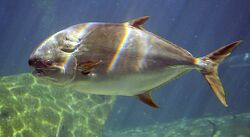Biology:Trachinotus africanus
| Trachinotus africanus | |
|---|---|

| |
| Trachinotus africanus at uShaka Marine World | |
| Scientific classification | |
| Domain: | Eukaryota |
| Kingdom: | Animalia |
| Phylum: | Chordata |
| Class: | Actinopterygii |
| Order: | Carangiformes |
| Family: | Carangidae |
| Genus: | Trachinotus |
| Species: | T. africanus
|
| Binomial name | |
| Trachinotus africanus J.L.B. Smith, 1967
| |
Trachinotus africanus. the Southern pompano or African pompano, is a species of marine ray-finned fish from the Indian Ocean.
Description
Trachinotus africanus is a very deep bodied fish, silver in colour with blue fins with yellow margins.[2] The fish has a blunt nose and does not have large spots.[3]
Distribution
Trachinotus africanus has a disjunct distribution with three populations. There is a population in the south-western Indian Ocean along the African costa from Knysna in South Africa to Delagoa Bay in Mozambique; a second population is in the northern Indian Ocean from the Gulf of Aden in Yemen to Karachi in Pakistan; and the third population is around Bali in Indonesia.[4][1] This species was described in 1967 by the South African ichthyologist James Leonard Brierley Smith (1897-1968) with the type locality given as Knysna.[5]
Habitat and biology
Trachinotus africanus is an inshore species of the surf zone which has a tolerance for water with low salinity and will enter estuaries. It is a bottom feeder which prefers the seaward edges of reefs which frequently forages for food in wave formed gullies in sandy substrates and along the edge of the wave zone. It is a solitary species.[2] The fish feed upon rock mussels, sand mussels, sand dollars, crabs, and mole crabs. The fish consumes these with a powerful pharyngeal dentition.[6]
Human interest and conservation
Trachinotus africanus is a quarry species for recreational shore and boat angling, spearfishing and subsistence fisheries in South Africa. It is a very popular species for recreational fishing in KwaZulu Natal and its commercial use is banned there, in the Western Cape fish caught in False Bay can be sold. There is a closed season which rules from 1 October to 30 November.[7]
The fish is lauded for being excellent table fare, being grilled or prepared on a braai.[3]
References
- ↑ 1.0 1.1 Smith-Vaniz, W.F.; Carpenter, K.E.; Borsa, P.; Obota, C.; Yahya, S.; Jiddawi, N. (2018). "Trachinotus africanus". IUCN Red List of Threatened Species 2018: e.T20436417A67871610. doi:10.2305/IUCN.UK.2018-2.RLTS.T20436417A67871610.en. https://www.iucnredlist.org/species/20436417/67871610. Retrieved 20 November 2021.
- ↑ 2.0 2.1 Bill Hansford-Steele (2013). African fly-fishing handbook A guide to freshwater and saltwater fly-fishing. Penguin Random House South Africa. ISBN 978-1432302290. https://books.google.com/books?id=dAlbDwAAQBAJ&q=southern+pompano+fish&pg=PT402.
- ↑ 3.0 3.1 Crous, Hennie (2013-09-26) (in en). Top Angling Fishes of SA: Find, catch, identify. Penguin Random House South Africa. ISBN 9781431701780. https://books.google.com/books?id=twhbDwAAQBAJ.
- ↑ Froese, Rainer and Pauly, Daniel, eds. (2019). "Trachinotus africanus" in FishBase. August 2019 version.
- ↑ Eschmeyer, William N.; Fricke, Ron; van der Laan, Richard, eds. "Trachinotus africanus". California Academy of Sciences. http://researcharchive.calacademy.org/research/ichthyology/catalog/fishcatget.asp?spid=24241.
- ↑ Randall, John E. (1995) (in en). Coastal Fishes of Oman. University of Hawaii Press. ISBN 9780824818081. https://books.google.com/books?id=LSuT-3GQL-QC.
- ↑ "Southern pompano". WWF. 29 December 2009. https://www.wwf.org.za/?1965/Southern%2520pompano.
Wikidata ☰ Q2219847 entry
 |


